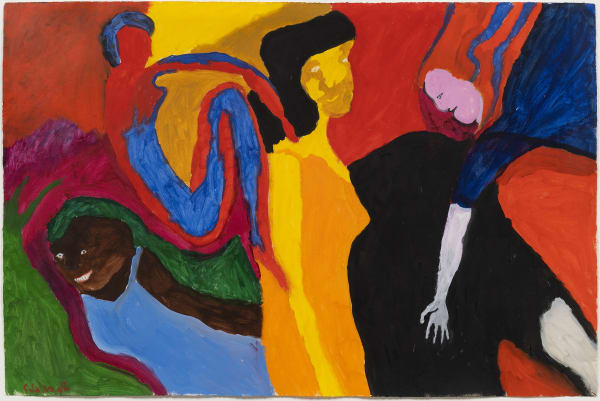Robert Colescott
Overview
Robert Colescott’s (b. 1925, Oakland, CA; d. 2009, Tucson, AZ) nearly six-decade painting career was a proud instigator who fearlessly tackled subjects of social and racial inequality, class structure, sex, and the human condition through his uniquely rhythmic and often manic style of figuration. Colescott's distinctive works, while not easily placed within any one specific school of painting, share elements of Abstract Expressionism, Pop Art, "Bad" Painting, Bay Area Figuration, Funk Art, Renaissance Painting, neo-Expressionism, and Surrealism.
Compositions that at first glance seem to tilt and spiral off of their axis are ultimately held together with a masterful sense of balance. Colescott's intense interest in critiquing painting's failure to accurately represent the Black experience is manifested in a lifetime of work that offers a revisionist art historical narrative and has subsequently influenced an entire generation of artists.
After serving in the US Army during World War II, Robert Colescott received a bachelor’s degree and, later, a master’s degree in art practice from the University of California, Berkeley. His studies continued in Paris under the tutelage of Fernand Léger, who was instrumental in Colescott’s embrace of the human figure as subject. He earned a prestigious Endowed Regents’ Professorship after a long career of teaching painting at academic institutions including the Portland State University, OR; The San Francisco Art Institute; University of California, Berkeley; and University of Arizona, Tucson; and held the distinction of being the first visiting professor of art at the American University in Cairo, Egypt in 1966 and 1967. In 1997, Robert Colescott was honored as the first African American artist to represent the United States with a solo exhibition at the 47th Venice Biennale, Venice, Italy.
Colescott’s work is represented in public collections internationally, in such notable institutions as the Akron Art Museum, Akron, OH; Art Bridges Foundation, Bentonville, AR; Baltimore Museum of Art, Baltimore, MD; Brooklyn Museum of Art, Brooklyn, NY; BY ART MATTERS, Hangzhou, China; California African American Museum, Los Angeles, CA; National Gallery of Art, Washington, D.C.; Crocker Museum of Art, Sacramento, CA; Dallas Museum of Art, Dallas, TX; Delaware Museum of Art, Wilmington, DE; Denver Museum of Art, Denver, CO; Detroit Institute of Arts, Detroit, MI; de Young Fine Arts Museums of San Francisco, CA; Hammer Museum, Los Angeles, CA; High Museum of Art, Atlanta, GA; Hirshhorn Museum & Sculpture Garden, Washington, D.C.; Los Angeles County Museum of Art, Los Angeles, CA; Lucas Museum of Narrative Art, Los Angeles, CA; Manetti Shrem Museum of Art, UC Davis, CA; Metropolitan Museum of Art, New York, NY; Morgan Library and Museum, New York, NY; Museum of Contemporary Art, Los Angeles, CA; Museum of Contemporary Art, Chicago, IL; Museum of Fine Arts, Boston, MA; Museum of Modern Art, New York, NY; Oakland Museum of California, Oakland, CA; Portland Museum of Art, Portland, OR; Pinault Collection, Paris, France; Rubell Family Collection, Miami, FL; San Francisco Museum of Modern Art, San Francisco, CA; Seattle Art Museum, Seattle, WA; Studio Museum in Harlem, New York, NY; Tucson Museum of Art, Tucson, AZ; Wadsworth Atheneum Museum of Art, Hartford, CT; Walker Art Center, Minneapolis, MN; Whitney Museum of American Art, New York, NY; among many more.
Works





